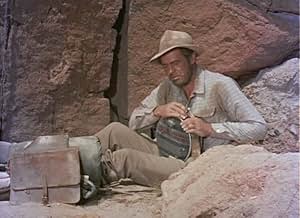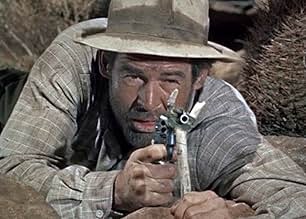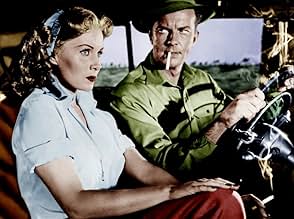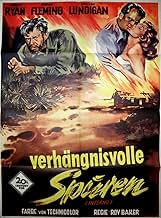PUNTUACIÓN EN IMDb
7,0/10
2 mil
TU PUNTUACIÓN
Añade un argumento en tu idiomaA tough, hard-driving business tycoon suffers a broken leg and is left to die in the desert by his scheming wife and her greedy lover.A tough, hard-driving business tycoon suffers a broken leg and is left to die in the desert by his scheming wife and her greedy lover.A tough, hard-driving business tycoon suffers a broken leg and is left to die in the desert by his scheming wife and her greedy lover.
- Dirección
- Guión
- Reparto principal
Robert Adler
- Ken - Ranch Hand
- (sin acreditar)
Harry Carter
- Deputy Fred Parks
- (sin acreditar)
Everett Glass
- Mason, Carson's Butler
- (sin acreditar)
James Gonzalez
- Hotel Guest
- (sin acreditar)
Adrienne Marden
- Emory's Secretary
- (sin acreditar)
Barbara Pepper
- Waitress
- (sin acreditar)
Charles Tannen
- Police Radio Broadcaster
- (sin acreditar)
Dan White
- Lee - Ranch Hand
- (sin acreditar)
Reseñas destacadas
Pretty inventive script, Robert Ryan helps pull off quite a bit of voice over dialog, nice photography, (I did see it in 3D) well paced there are a number of clever script/plot elements that keep it going and a great fight scene(which features most of the 3D Fx in the movie).
Sort of a desert Film Noir really, well directed by the mostly always good Roy (Ward) Baker this holds up. There is constant cross cutting between Ryan's plight in the desert and the two villains swimming or eating and drinking that really builds your hatred of them and your siding with Ryan.
No mamsey pamsey character softening here, which keeps it tough, but reality based, throughout. It's not a cartoon at any moment which can happen with B films. Though also perhaps the limited character development keeps it slightly in the programmer category. Good music score by Paul Sawtell as well. This movie moves quickly doesn't have the soapy elements, or bloated running time, that killed off many color crime films in the 1950's.
Sort of a desert Film Noir really, well directed by the mostly always good Roy (Ward) Baker this holds up. There is constant cross cutting between Ryan's plight in the desert and the two villains swimming or eating and drinking that really builds your hatred of them and your siding with Ryan.
No mamsey pamsey character softening here, which keeps it tough, but reality based, throughout. It's not a cartoon at any moment which can happen with B films. Though also perhaps the limited character development keeps it slightly in the programmer category. Good music score by Paul Sawtell as well. This movie moves quickly doesn't have the soapy elements, or bloated running time, that killed off many color crime films in the 1950's.
In the history of motion pictures only two ideas (as far as I know) failed to catch on in improving the movies we see. One is the laughable "Aroma-vision" that was tried out in the late 1950s with a film that Peter Lorre and Desmond Elliot made called SCENT OF MYSTERY. People just don't like certain odors that can be on the screen in films. But the other was an 3-D, which should have succeeded. If you want to have a more realism in movies, then you should have a movie where depth adds some degree of reality. But 3-D was not used properly. The best recalled uses are in grade z films like ROBOT MONSTER. The best uses of the process were in Alfred Hitchcock's DIAL "M" FOR MURDER, in the Vincent Price horror classic HOUSE OF WAX, and in INFERNO. But while Hitchcock's and Price's films are well remembered (and seen frequently), INFERNO has been generally ignored.
It stars Robert Ryan, Rhonda Fleming, William Lundigan, Larry Keating, and Henry Hull. Ryan begins the film in one of his typically negative characterizations - a millionaire married to Fleming who treats everyone around him as a servant to do his bidding. Sort of like a follow up to his Smith Ohlrig in CAUGHT, only with a new bride. He is going on vacation, and he is accompanied by his wife and a guide played by Lundigan. But Fleming and Lundigan are having a love affair, and when Ryan is injured they realize that they can get rid of him, collect his fortune, and then marry. They leave the obnoxious millionaire in the desert with just a six shooter and a canteen with water. He also has a broken leg. They figure they can report he wandered off, they could not trace him, and in a week the police can find his corpse.
Ryan fools them. Always intelligent in his roles, he growls as soon as he is alone, "They think I'll drink up all my water!" He starts an enforced rationing. He also makes a crutch. Finally he shows his patience in becoming a careful hunter - carefully using his gun to kill game only when it is available. Soon he is able to start following the stars to get back to civilization. And his disappearance is not being casually dismissed by the discovery of his body by the authorities led by Carl Betz. And Fleming and Lundigan are beginning to get nervous - and a bit less lovey-dovey with each other.
But the best part of this film, aside from the careful script and performances, was director Roy Baker's brilliant use of 3-D. He wanted the size of that desert Ryan is marooned in to be really evident to the audience, and his shots of the miles of mesas and sand are deeply impressive. It adds to one's realization of just what Ryan is up against to survive. Actually it was the best use of the process in Hollywood movies, and it makes one regret that John Ford did not think of using the process in say THE SEARCHERS or TWO RODE TOGETHER. Ford's use of "Monument Valley" was always brilliant - imagine if it too had been in 3-D.
It stars Robert Ryan, Rhonda Fleming, William Lundigan, Larry Keating, and Henry Hull. Ryan begins the film in one of his typically negative characterizations - a millionaire married to Fleming who treats everyone around him as a servant to do his bidding. Sort of like a follow up to his Smith Ohlrig in CAUGHT, only with a new bride. He is going on vacation, and he is accompanied by his wife and a guide played by Lundigan. But Fleming and Lundigan are having a love affair, and when Ryan is injured they realize that they can get rid of him, collect his fortune, and then marry. They leave the obnoxious millionaire in the desert with just a six shooter and a canteen with water. He also has a broken leg. They figure they can report he wandered off, they could not trace him, and in a week the police can find his corpse.
Ryan fools them. Always intelligent in his roles, he growls as soon as he is alone, "They think I'll drink up all my water!" He starts an enforced rationing. He also makes a crutch. Finally he shows his patience in becoming a careful hunter - carefully using his gun to kill game only when it is available. Soon he is able to start following the stars to get back to civilization. And his disappearance is not being casually dismissed by the discovery of his body by the authorities led by Carl Betz. And Fleming and Lundigan are beginning to get nervous - and a bit less lovey-dovey with each other.
But the best part of this film, aside from the careful script and performances, was director Roy Baker's brilliant use of 3-D. He wanted the size of that desert Ryan is marooned in to be really evident to the audience, and his shots of the miles of mesas and sand are deeply impressive. It adds to one's realization of just what Ryan is up against to survive. Actually it was the best use of the process in Hollywood movies, and it makes one regret that John Ford did not think of using the process in say THE SEARCHERS or TWO RODE TOGETHER. Ford's use of "Monument Valley" was always brilliant - imagine if it too had been in 3-D.
I was born the year this picture was made, 1953. I had no idea who Robert Ryan was until a few months ago. What a tremendous actor he was! and Inferno is one of his best! The man never got the recognition he deserved and today he's an unknown to most.
The 3D is exceptional on the DVD even when viewing in 2D which I tried. The Technicolor saturated colors which were a staple of 50's films is amazing. One scene with Ronda Fleming in a purple evening dress with her lover William Lundigan in a deep blue suit just pop out of the screen, they are so vibrant. These 2 characters were despicable adulterers who setup and planned a way to leave Ryan to die in the desert. He survives the hard elements of the desert, meeting many tough events. It moves fast, the cinematography, especially in the desert is outstanding. By all means see it! Highly Recommended!
The 3D is exceptional on the DVD even when viewing in 2D which I tried. The Technicolor saturated colors which were a staple of 50's films is amazing. One scene with Ronda Fleming in a purple evening dress with her lover William Lundigan in a deep blue suit just pop out of the screen, they are so vibrant. These 2 characters were despicable adulterers who setup and planned a way to leave Ryan to die in the desert. He survives the hard elements of the desert, meeting many tough events. It moves fast, the cinematography, especially in the desert is outstanding. By all means see it! Highly Recommended!
Inferno is a small but excellent 1953 film about a beautiful woman (Rhonda Fleming) and her lover (William Lundigan) who leave the woman's husband (Robert Ryan) alone in the desert with a broken leg, assuming he'll croak. The story focuses on Ryan's character trying to survive in the desert and what he learns about himself.
With gorgeous Rhonda Fleming in the movie, it's done in color. A chimpanzee could have played her part - there's precious little acting involved - but she certainly adds tremendous beauty to the production. She and another spectacular redhead, Arlene Dahl, both were getting larger roles in films at the time the studio system was winding down. Ten years earlier, they might have ruled the world. William Lundigan is appropriately cold-blooded as her horny lover, and Larry Keating is an appropriately concerned business associate.
But this is Ryan's film, and he's top-notch. His thoughts come over as voice-over, and you're pulling for him every step of the way, despite everyone describing him as unpleasant.
Excellent film, quite a surprise.
With gorgeous Rhonda Fleming in the movie, it's done in color. A chimpanzee could have played her part - there's precious little acting involved - but she certainly adds tremendous beauty to the production. She and another spectacular redhead, Arlene Dahl, both were getting larger roles in films at the time the studio system was winding down. Ten years earlier, they might have ruled the world. William Lundigan is appropriately cold-blooded as her horny lover, and Larry Keating is an appropriately concerned business associate.
But this is Ryan's film, and he's top-notch. His thoughts come over as voice-over, and you're pulling for him every step of the way, despite everyone describing him as unpleasant.
Excellent film, quite a surprise.
The best thing about Inferno is that, like the Aeneid, it jumps right into the middle of the action. Out in a southwestern desert, under the baking sun, lies Robert Ryan, with his leg broken and only a meager supply of food and water. He's been left to die by his wife (Rhonda Fleming) and her lover (William Lundigan). There's no backstory, no lead-up to the crucial events; what little we need to know gets doled out as the movie advances, but never in flashback.
Of course, anybody can be left to die in the desert by a philandering spouse, but it helps if you're a millionaire, like Ryan. We learn that he inherited his fortune and wonders whether he deserves it, and that he's a tough and private man who suffers no fools gladly (the part's basically a reworking of Ryan's Smith Ohlrig in Max Ophuls' Caught).
The rest of Inferno cross-cuts between Ryan's attempts to survive by his wits and Fleming's and Lundigan's to throw the local police and Ryan's business associates back in Los Angeles off track. After several days elapse, when it becomes apparent that Ryan may still be alive and on the move, Fleming and Lundigan decide that, in order to save themselves, they have to go back and finish the job....
Inferno was issued in 1953, the annus mirabilis of 3-D. Unlike most titles filmed in that short-lived gimmick, it stands pretty well on its own even the hurtling rocks, striking rattlers and flaming rafters stay effective without knocking viewers over the head. But basically it's a story of a man born to wealth who, to stay alive, must negotiate a deadly wilderness where money proves worthless. Watching Ryan do so is worth giving Inferno a look.
Of course, anybody can be left to die in the desert by a philandering spouse, but it helps if you're a millionaire, like Ryan. We learn that he inherited his fortune and wonders whether he deserves it, and that he's a tough and private man who suffers no fools gladly (the part's basically a reworking of Ryan's Smith Ohlrig in Max Ophuls' Caught).
The rest of Inferno cross-cuts between Ryan's attempts to survive by his wits and Fleming's and Lundigan's to throw the local police and Ryan's business associates back in Los Angeles off track. After several days elapse, when it becomes apparent that Ryan may still be alive and on the move, Fleming and Lundigan decide that, in order to save themselves, they have to go back and finish the job....
Inferno was issued in 1953, the annus mirabilis of 3-D. Unlike most titles filmed in that short-lived gimmick, it stands pretty well on its own even the hurtling rocks, striking rattlers and flaming rafters stay effective without knocking viewers over the head. But basically it's a story of a man born to wealth who, to stay alive, must negotiate a deadly wilderness where money proves worthless. Watching Ryan do so is worth giving Inferno a look.
¿Sabías que...?
- CuriosidadesWhen the cast and crew arrived at the Mojave Desert location it was covered in snow and Rhonda Fleming subsequently developed pneumonia.
- PifiasEarly in the movie, after Robert Ryan has put a splint on his broken leg (which continues to cause him a lot of pain), he takes a small branch and breaks it over the injured leg, seemingly without feeling any pain.
- Citas
Donald Whitley Carson III: [after finding water in a cactus] This stuff's a great discovery. Just sit there and work on it all day and you can get enough juice to sit there and work on it all day.
- Versiones alternativasAlso shown in a 3D version.
- ConexionesFeatured in A New Dimension in Noir: Filming Inferno in 3D (2017)
Selecciones populares
Inicia sesión para calificar y añadir a tu lista para recibir recomendaciones personalizadas
- How long is Inferno?Con tecnología de Alexa
Detalles
Taquilla
- Presupuesto
- 1.055.000 US$ (estimación)
- Duración1 hora 23 minutos
- Relación de aspecto
- 1.33 : 1
Contribuir a esta página
Sugerir un cambio o añadir el contenido que falta

Principal laguna de datos
By what name was Infierno (1953) officially released in India in English?
Responde



































